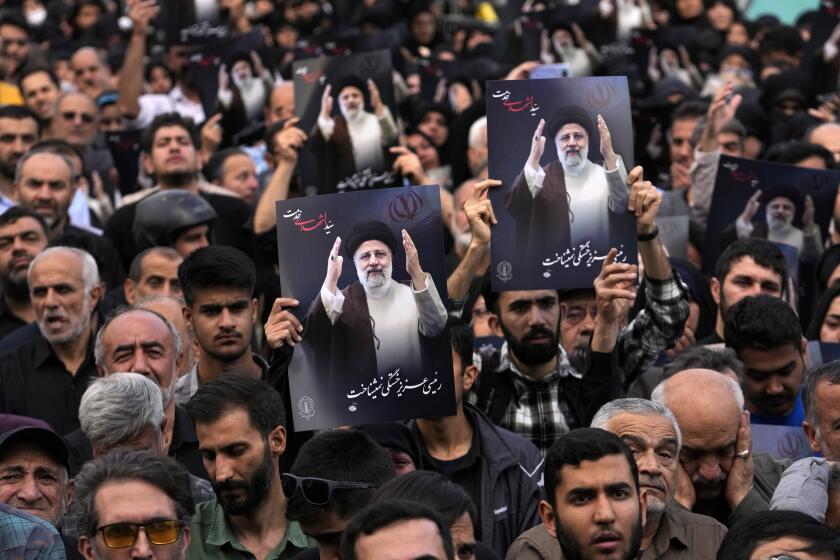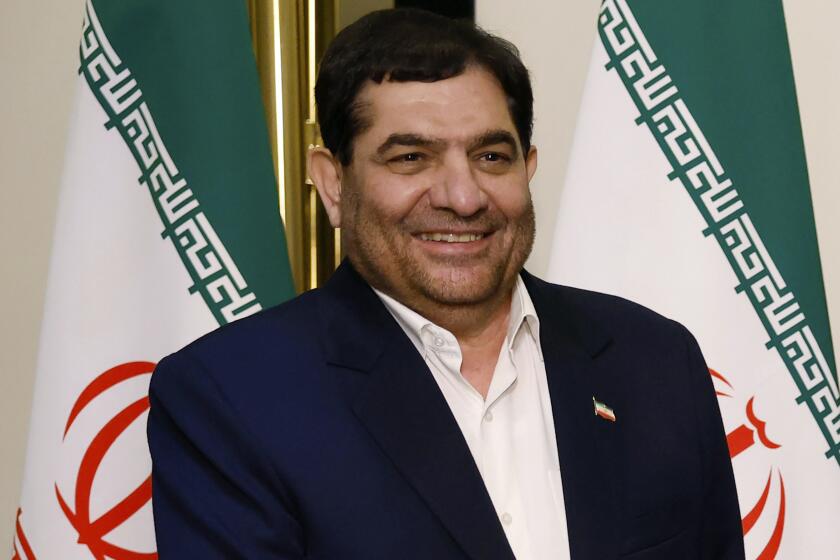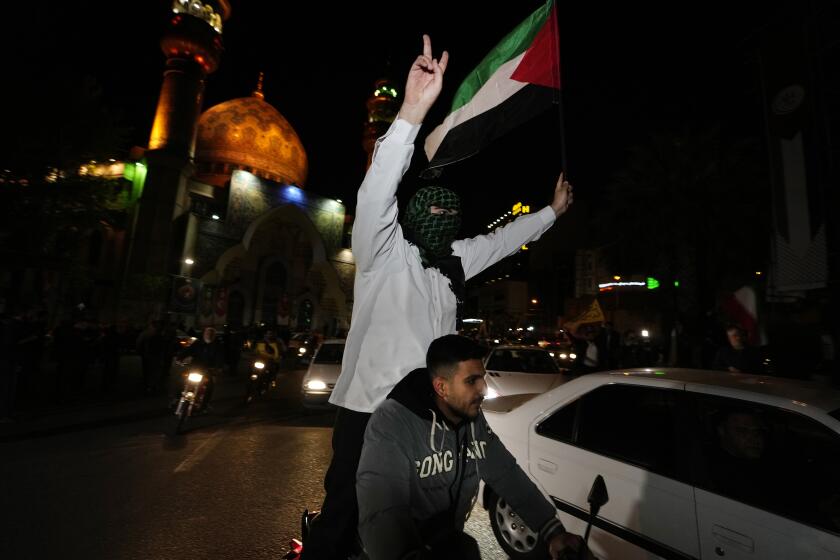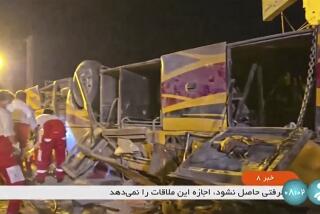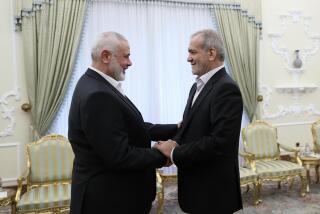Iran inters its late president at holiest Shiite site in nation
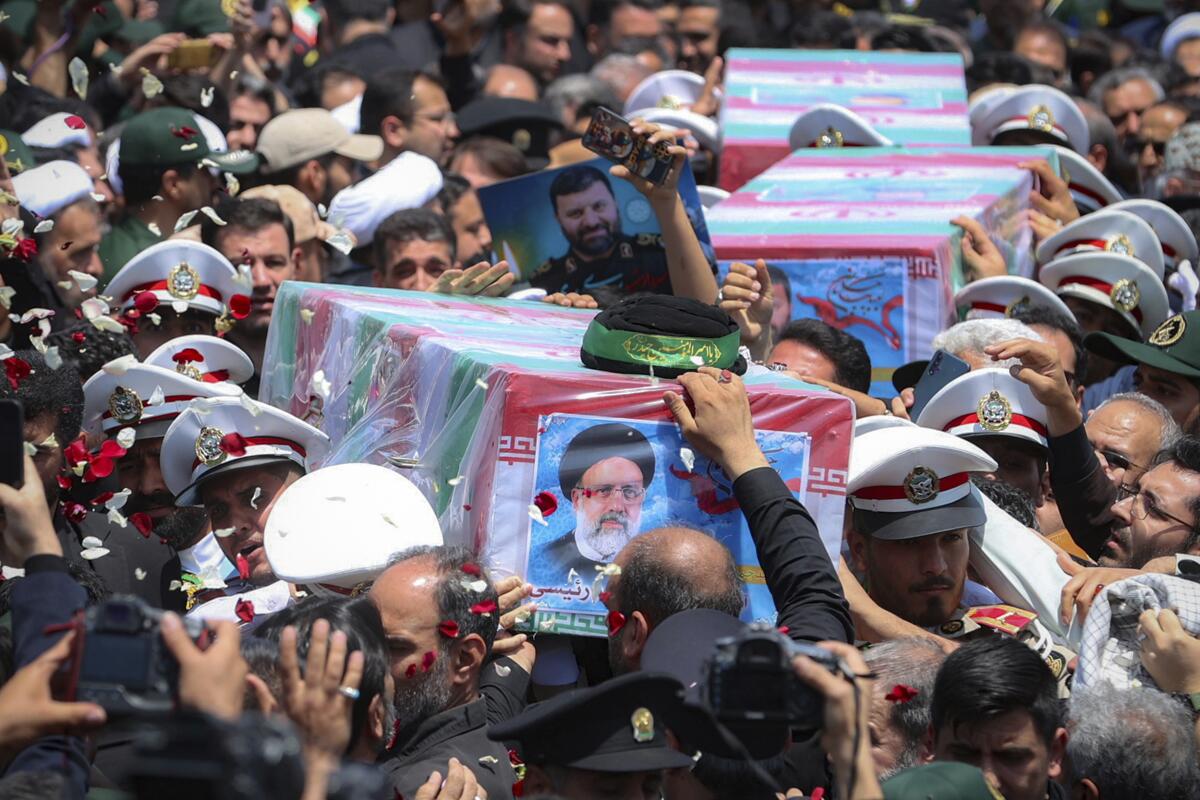
- Share via
DUBAI, United Arab Emirates — Iran interred President Ebrahim Raisi at the nation’s holiest Shiite shrine Thursday, days after he was killed in a helicopter crash that added to the woes of a country already beset by international sanctions, internal unrest and tensions abroad.
Raisi, who died alongside the country’s foreign minister and six others, was lowered by mourners into a tomb at the Imam Reza Shrine in Mashhad, where Shiite Islam’s eighth imam is buried and millions of pilgrims visit each year. Hundreds of thousands of people dressed in black crowded around the shrine under its iconic golden dome, wailing and beating their chests in sorrow in a sign of mourning common in Shiite ceremonies.
A hadith, or saying, attributed to the prophet Muhammad states that anyone with sorrow or sin will be relieved by visiting there. But Thursday’s mass processional offered little salve for Iran and its many challenges.
The days of services for Raisi have not drawn the same crowds in this nation of over 80 million people as the 2020 gatherings for Revolutionary Guard Gen. Qassem Soleimani, who was slain by a U.S. drone strike in Baghdad.
In Tehran alone, an estimated 1 million people turned out in the streets for Soleimani — something onlookers said they didn’t see at the men’s commemorations Wednesday. Yet the ceremonies have repeatedly invoked the general and included his image, which is likely to spark an association between the men.
Iran has spent decades supporting armed groups and militants in Lebanon, Syria, Iraq, Yemen and Palestinian territories, allowing it to project power.
It’s a potential sign of the public’s feelings about Raisi’s presidency, which included a harsh government crackdown on dissent during protests over the 2022 death of Mahsa Amini, who was detained for allegedly not wearing her mandatory headscarf to authorities’ liking.
That crackdown, as well as Iran’s struggling economy, has gone unmentioned in the hours of coverage provided by state television and in newspapers. Never discussed was Raisi’s involvement in the mass execution of an estimated 5,000 dissidents at the end of the Iran-Iraq war.
Little information has emerged about the cause of the crash of the aging Bell helicopter that went down in a foggy, mountainous region. The country’s security forces were expected to investigate in the coming days.
Prosecutors have warned against any public signs of celebration around Raisi’s death, and a heavy security presence has been seen in Tehran since the crash.
Raisi, 63, had been discussed as a possible successor to Iran’s supreme leader, the 85-year-old Ayatollah Ali Khamenei. The next presidential election is set for June 28. For now, there’s no clear favorite for the position among Iran’s political elite — particularly no one who is a Shiite cleric, like Raisi.
Iran’s first vice president, Mohammad Mokhber, has been appointed president of the Islamic Republic after the death of President Ebrahim Raisi in a helicopter crash.
Acting President Mohammad Mokhber, a relatively unknown first vice president until Sunday’s crash, has stepped into his role and even attended a meeting between Khamenei and Hamas leader Ismail Haniyeh on Wednesday.
Mashhad served as a longtime base for Raisi. In 2016, Khamenei appointed Raisi to run the Imam Reza charity foundation, which manages a vast conglomerate of businesses and endowments in Iran, as well as oversees the shrine. It is one of many bonyads, or charitable foundations, fueled by donations or assets seized after Iran’s 1979 Islamic Revolution.
These foundations offer no public accounting of their spending and answer only to Iran’s supreme leader. The Imam Reza charity, known as “Astan-e Quds-e Razavi” in Farsi, is believed to be one of the biggest in the country. Analysts estimate its worth at tens of billions of dollars as it owns almost half the land in Mashhad, Iran’s second-largest city, about 470 miles east of Iran’s capital, Tehran.
Raisi is the first top politician in the country to be buried at the shrine, which represents a major honor for the cleric. His father-in-law serves as the city’s Friday prayer leader.
The deaths of Raisi and Foreign Minister Hossein Amirabdollahian come as Iran continues to back militia groups in the wider Mideast to pressure its enemies, namely Israel and the United States. Mourners have chanted against both nations in the ceremonies.
Iran launched a drone and missile attack on Israel in a significant escalation of regional conflict amid the Israel-Hamas war in Gaza. Israel says it intercepted the ‘vasty majority.’
State media circulated photos Thursday showing a meeting between Iran’s paramilitary Revolutionary Guard chief and the head of its expeditionary Quds Force and representatives from Hamas, Lebanon’s Hezbollah and Yemen’s Houthi rebels.
On Thursday morning, thousands of people dressed in black gathered along a main boulevard in the city of Birjand, where Raisi once served as its member on the Assembly of Experts in Iran’s South Khorasan province along the Afghan border. There and in Mashhad, mourners on the streets reached out to a truck carrying his casket, with some tossing scarves and other items against it for a blessing.
Meanwhile, former Foreign Ministers Mohammed Javad Zarif and Ali Akbar Salehi and other dignitaries paid respects to Amirabdollahian at Iran’s Foreign Ministry, where his casket was put on display. His body later was interred in Shahr-e Rey just outside of Tehran at the Abdol Azim shrine, another final resting place for those famed in Persian history.
“Give Soleimani our greetings,” a religious singer said as Amirabdollahian’s body was put into its final resting place, referring to the slain general.
Gambrell writes for the Associated Press. AP writer Amir Vahdat in Tehran, Iran, contributed to this report.
More to Read
Sign up for Essential California
The most important California stories and recommendations in your inbox every morning.
You may occasionally receive promotional content from the Los Angeles Times.
